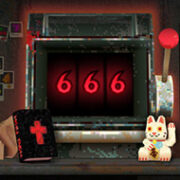Blame Him

Blame Him is a first-person psychological horror game that drops players into a dark, unfamiliar environment with only a flashlight and their instincts. The experience focuses on tension, atmosphere, and puzzle-solving, challenging players to uncover a fragmented narrative while navigating through eerie corridors haunted by a looming threat.
Waking Into Darkness
The game begins with the player regaining consciousness in an abandoned, dimly lit space with no clear exit and no memory of how they arrived. From the very first step, Blame Him instills unease through disjointed visuals, narrow hallways, and environmental details that hint at a deeper story. Exploration is key—every object, sound, and shadow might be part of the mystery or part of the threat.
Players advance by opening doors, triggering environmental events, and solving logic-based puzzles. Most areas are non-linear, offering multiple paths that can be unlocked based on exploration. The spaces often loop or transform, making orientation a real challenge. Subtle shifts in lighting and geometry make familiar places feel suddenly dangerous. The game doesn’t rely on jump scares, but the anxiety of being watched never goes away.
Gameplay Loop and Threat Management
Blame Him uses stealth and exploration as its primary mechanics. The player must avoid a mysterious enemy that stalks certain zones, moving silently and unpredictably. There are no weapons, no combat options—survival depends on staying quiet, using the environment, and recognizing danger before it arrives. The flashlight is both a lifeline and a liability: it reveals paths and clues, but may also expose the player to whatever lurks in the dark.
Key gameplay elements include:
- Environmental puzzles that require players to manipulate objects, symbols, or mechanisms
- Audio cues that hint at the enemy’s location, movement, or triggers
- Exploration incentives—finding notes, keys, and hidden routes can unlock lore and secret endings
As the story unfolds, players are forced to confront not only the creature, but also fragments of a traumatic past that tie directly to the protagonist’s identity. The game challenges players to ask whether the threat is external or internal.
Hidden Layers and Player Strategy
One frequently asked question is whether Blame Him has alternate endings. It does—choices made during certain puzzles or exploration paths can lead to multiple conclusions. Additionally, specific secrets, such as hidden rooms or messages, only appear if certain items are collected in a particular order.
To navigate the game more effectively, players should:
- Turn off the flashlight occasionally and listen—many threats are audio-based
- Backtrack after key events; new paths often unlock silently
- Pay close attention to environmental storytelling—graffiti, photos, and layouts reveal crucial clues
Blame Him builds dread through ambiguity and careful pacing. For players who enjoy a slow-burn experience that demands attention to detail and rewards persistence, this game offers a psychologically heavy journey into fear and regret.
























